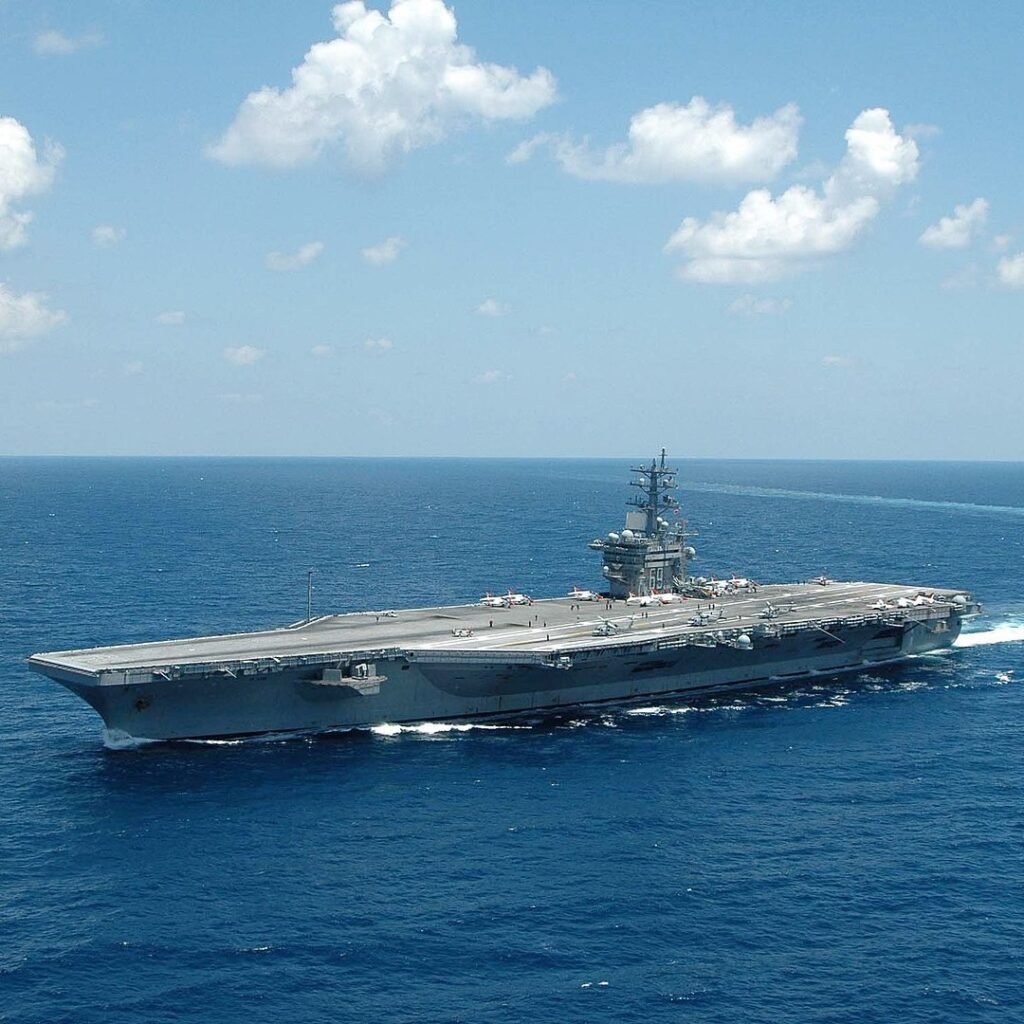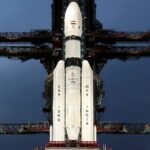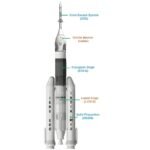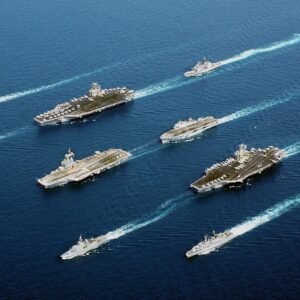The USS Dwight D Eisenhower (CVN-69) is a Nimitz-class aircraft carrier of the United States Navy. It is one of the biggest warships in the world, named for Dwight D. Eisenhower, the 34th President of the United States. The ship was commissioned on October 18, 1977, and it has been a vital component of the U.S. Navy’s carrier strike group capabilities.
As a nuclear-powered aircraft carrier, it is capable of carrying a wide array of aircraft, including multiple aircraft. The USS Dwight D Eisenhower has been involved in various military operations and exercises, contributing to the defense and power projection capabilities of the United States Navy.

I. Latest News
The USS Dwight D Eisenhower Aircraft Carrier Strike Group (CSG), armed with nuclear weapons, was ordered to relocate to the Eastern Mediterranean on October 14, according to US Defense Secretary Austin Lloyd. This location is directly adjacent to the continuing confrontation between Israel and the militant group Hamas.
The USS Dwight D. Eisenhower aircraft carrier will join the USS Gerald R. Ford aircraft carrier Strike Group, which arrived in the area earlier this week, according to a statement detailing the move as part of the US effort to “deter hostile actions against Israel or any efforts toward widening this war following Hamas’s attack on Israel.” The US Navy’s newest and most sophisticated aircraft carrier to date is USS Gerard R. Ford.
II. The USS Dwight D. Eisenhower Aircraft Carrier Design
- Nuclear Power: The ship is powered by two nuclear reactors. Which provide significant endurance and allow for extended operations without the need for refueling.
- Flight Deck and Hangars: The flight deck is about 4.5 acres in size and is equipped with four steam-powered catapults for launching aircraft. There are also four arresting cables for aircraft recovery. The hangar deck below the flight deck is used for aircraft storage and maintenance.
- Aircraft Capacity: It can accommodate a large air wing consisting of various aircraft, including fighter jets, early warning aircraft, electronic warfare planes, and helicopters. The specific composition of the air wing may vary depending on the mission requirements.
- Defensive Capabilities: The USS Dwight D. Eisenhower is equipped with advanced radar and electronic warfare systems, as well as various missile defense systems, to protect itself. Its accompanying fleet from potential threats.
- Command and Control Center: It features a sophisticated command and control center that allows for effective coordination of operations, communications, and intelligence gathering.
- Propulsion and Speed: Its nuclear propulsion system provides significant speed and endurance, enabling it to travel at high speeds for extended periods.
- Crew Accommodations: The ship is designed to accommodate a large number of crew members.

III. The USS Dwight Aircraft Carrier Development
- Design and Planning: The initial stages would have involved the design and planning of the ship, incorporating the latest technologies and advancements in naval warfare, aviation, and nuclear propulsion. The design process would have focused on creating a platform capable of supporting a diverse array of aircraft and missions.
- Construction and Assembly: The construction and assembly of the USS Dwight D. Eisenhower would have taken place at a shipyard, involving the integration of various components, including the nuclear reactors, flight deck, hangars, and other critical systems. The construction process would have required precision engineering and careful coordination to ensure the ship’s structural integrity and functionality.
- Integration of Advanced Systems: The integration of advanced radar systems, electronic warfare capabilities, and defensive armaments would have been a crucial part of the development process, allowing the USS Dwight D. Eisenhower to operate effectively in various environments and combat scenarios.
- Testing and Evaluation: Extensive testing and evaluation would have been conducted to ensure the ship’s performance met the stringent standards set by the U.S. Navy. This would have included sea trials, propulsion tests, and evaluations of the ship’s various systems and capabilities under different operational conditions.
- Training and Deployment: As the ship neared completion, training programs would have been conducted to familiarize the crew with the USS Dwight D. Eisenhower’s operations, systems, and protocols. Following successful testing and training, the USS Dwight D. Eisenhower would have been deployed for various missions and operations to showcase its capabilities and contribute to the U.S. Navy’s strategic objectives.

IV. Key Specification of The Aircraft Carrier
| Specification | Details |
| Class | Nimitz-class aircraft carrier |
| Namesake | Dwight D. Eisenhower, 34th President of the United States |
| Ordered | June 1970 |
| Builder | Newport News Shipbuilding, Virginia, USA |
| Laid down | August 15, 1970 |
| Launched | October 11, 1975 |
| Commissioned | October 18, 1977 |
| Displacement | Approximately 101,600 tons (at full load) |
| Length | 1,092 feet (332.8 meters) |
| Beam | 134 feet (40.8 meters) |
| Draft | 37 feet (11.3 meters) |
| Propulsion | 2 × Westinghouse A4W nuclear reactors, 4 steam turbines |
| Speed | 30+ knots (56+ km/h; 35+ mph) |
| Range | Essentially unlimited, with provisions lasting 20 years |
| Complement | Ship’s Company: 3,200-3,300; Air Wing: 2,480 |
| Sensors | AN/SPS-48E 3-D air search radar, AN/SPS-49(V)5 air search radar, AN/SPQ-9B target acquisition radar, AN/SPN-46 air traffic control radar, various other sensors and processing systems |
| Aircraft Capacity | Approximately 85-90 fixed-wing and rotary-wing aircraft |
| Armament | 2 × RIM-7 Sea Sparrow missile launchers, 2 × RIM-116 Rolling Airframe Missile (RAM) systems, 3 × Phalanx CIWS, 4 × .50 caliber machine guns |
| Aircraft carried | F/A-18 Hornet, E-2 Hawkeye, C-2 Greyhound, EA-18G Growler, MH-60R/S Seahawk, and other supporting aircraft |
| Cost | Approximately $5.1 billion USD (at the time of construction) |
| Motto | “Isis Ultio” (Wrath of the Gods) |

A. The USS Dwight D. Eisenhower Carried Multiple Aircraft Carrier
The USS Dwight D. Eisenhower (CVN-69) is capable of carrying a diverse array of fixed-wing and rotary-wing aircraft, enabling it to perform a wide range of missions and operations.
a. Fixed-Wing Aircraft:
- F/A-18 Hornet: Multirole fighter jet used for both air-to-air and air-to-ground missions.
- EA-18G Growler: Electronic warfare aircraft designed for suppression of enemy air defenses.
- E-2 Hawkeye: Airborne early warning and control (AEW&C) aircraft used for surveillance and command and control.
b. Rotary-Wing Aircraft:
- MH-60R Seahawk: Multi-mission helicopter used for anti-submarine warfare, search and rescue, and anti-surface warfare.
- MH-60S Seahawk: Multi-mission helicopter used for various purposes, including search and rescue, logistics support, and anti-surface warfare.
- C-2 Greyhound: Carrier-based transport aircraft primarily used for the transportation of supplies, personnel, and mail to and from aircraft carriers.
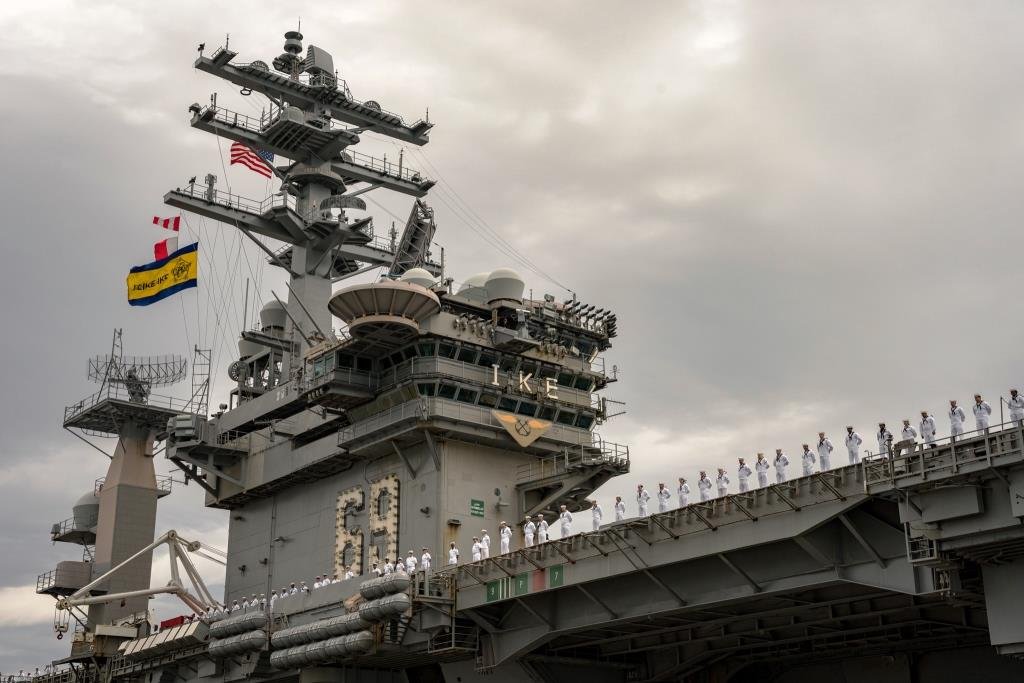
B. The USS Dwight D. Eisenhower CVN-69 Armaments
The USS Dwight D. Eisenhower (CVN-69) is equipped with a range of armaments that provide it with formidable offensive and defensive capabilities. These armaments include various missile systems, close-in weapon systems (CIWS), and other defensive and offensive weaponry.
a. Missile Systems:
- RIM-7 Sea Sparrow: A medium-range, semi-active radar-homing surface-to-air missile used for defense against anti-ship missiles and enemy aircraft.
- RIM-116 Rolling Airframe Missile (RAM): A lightweight, quick-reaction, fire-and-forget missile used for point defense against anti-ship missiles and aircraft.
b. Close-In Weapon Systems (CIWS):
- Phalanx CIWS: A rapid-fire, computer-controlled radar and 20mm Gatling gun system used for defense against anti-ship missiles and close-in air and surface threats.
c. Additional Armaments:
- .50 caliber machine guns: Used for anti-aircraft and close-in defense.
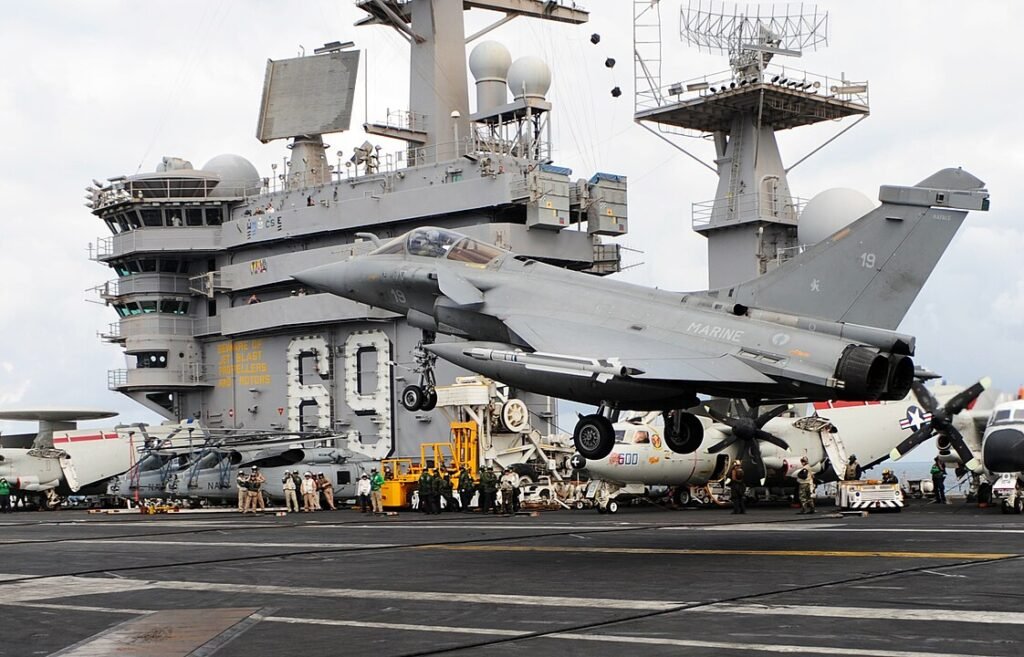
V. The USS Dwight D Eisenhower Aircraft Carrier War History
The USS Dwight D. Eisenhower (CVN-69) has been involved in several significant military operations and exercises, contributing to the United States Navy’s global presence and defense strategy.
- Gulf War: The USS Dwight D. Eisenhower participated in Operation Desert Storm in the early 1990s, playing a crucial role in the coalition forces’ efforts to liberate Kuwait from Iraqi occupation.
- Operation Enduring Freedom and Operation Iraqi Freedom: The USS Dwight D. Eisenhower contributed to operations in Afghanistan and Iraq following the 9/11 terrorist attacks, supporting coalition forces and conducting air operations as part of the War on Terror.
- Operation Inherent Resolve: The USS Dwight D. Eisenhower was involved in Operation Inherent Resolve, the U.S.-led intervention against the Islamic State of Iraq and Syria (ISIS) in the Middle East.
- Various Training Exercises and Humanitarian Missions: The USS Dwight D. Eisenhower has participated in numerous multinational training exercises and humanitarian missions, showcasing its role in promoting regional stability, fostering alliances, and enhancing naval capabilities.
You Know about the Russian Admiral Kuznetsov Aircraft Carrier – Deadly Weapon

